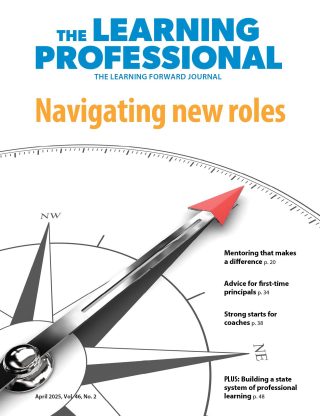FEATURE ARTICLE
A Step In The Right Direction
Learning Walk Brings Districts Together To Examine Teacher Evaluation And Support Roles
By Learning Forward
October 2012
Vol. 33 No. 5
In a private room at the back of a busy restaurant just outside of Tampa, Fla., drinks and appetizers went unnoticed as 12 diners sat around one large table and engaged in multiple rapid-fire conversations about professional learning. On one side of each conversation were representatives of Memphis (Tenn.) City Schools. The district was in its fourth year of a reform effort called the Teacher Effectiveness Initiative, designed to close student achievement gaps by ensuring that every student has an effective teacher every day. On the other side of each conversation sat a representative of Hillsborough County (Fla.) Public Schools, a district that has recently been recognized for its teacher evaluation and support reforms using a peer and mentor program.
The conversations covered the spectrum of work for each office, from processes, data technology, and resources to creating buy-in, providing incentives, and developing culture. Representatives of central office staff from each district took notes any way they could, on napkins, to-go menus, or cell phones. Handwritten notes covered the meeting facilitator’s handouts and filled the margins. The discussions were a mixture of casual conversations, serious analyses of professional learning philosophies, dining selections, and dessert choices.
What had inspired such a productive learning experience with this kind of frantic pace? The meeting was part of a learning walk experience set up by Learning Forward’s Center for Results to offer Memphis central office staff a rare opportunity to meet face-to-face with staff from a district that had successfully navigated challenges similar to the ones Memphis faced.
Memphis City Schools had begun its Teacher Effectiveness Initiative by redefining what it means to be an effective teacher and used that definition to create new teacher effectiveness measures that would guide the district’s decisions, support, and professional learning for teachers. The district sought to align its existing professional development with newly created teacher effectiveness measures, but it was a monumental task for such a large system, and Memphis leaders knew they couldn’t do it alone.
“We were facing a large undertaking,” said Monica Jordan, coordinator of reflective practice and instructional support for Memphis City Schools. “We had more than 80 courses available, but we had to ask: Are they all matching teachers’ needs? Is the strength of the teacher considered? Is his or her practice getting better? We had several conversations about how big and complicated this was.”
As part of an agreement with the Bill & Melinda Gates Foundation, Learning Forward’s Center for Results helped Memphis develop a change leadership plan for the monumental task that lay ahead. According to the Center’s Site Visit Protocol (see box on p. 53), looking at exemplars and models of successful professional learning programs “creates a vision of how they can establish effective, results-oriented communities of learners” (Psencik, n.d., p. 1). To go beyond simply reading about exemplar districts, though, the plan included a series of site visits that would give staff from Memphis an inside look at successful systems around the country through in-person meetings and guided tours.
The task ahead for Memphis was more than a simple realignment of goals. “We wanted people at every level to know exactly what they should do for their professional learning, whether it was coaching, a professional development session, or an online option,” Jordan said. “We needed a deeper analysis of our program. We knew we needed pre- and post-observation data, pre- and post-student achievement analysis to see what’s working. Plus, we wanted to build in choice and differentiation.”
Hillsborough had been chosen for this visit because of the district’s similarity to the challenges facing Memphis. Numerous inconsistencies existed within Hillsborough’s teacher evaluation system, including tenuous links to professional learning, so the district set out to revamp the system in 2008 (von Frank, 2011, p. 32). Ultimately, Hillsborough instituted a peer and mentor system tied to teacher evaluations. Mentors guide teachers for their first two years of service. According to David Steele, chief information and technology officer for Hillsborough, these mentors don’t conduct teacher observations during this time. This eliminates trust issues that can cloud communications in evaluative relationships. Peers, on the other hand, are trained, full-time observers for the teacher evaluation system.
Hillsborough’s successful revamping of its teacher evaluation system includes using multiple measures of teacher effectiveness, which is a key first step in creating a high-performing system (Bill & Melinda Gates Foundation, 2010, p. 9), so Memphis leaders knew the district represented a valuable learning opportunity.
To guide district participants through an inquiry process based on Learning Forward’s Standards for Professional Learning, the Center for Results created the Site Visit Protocol. The process helps districts identify “the professional learning planned, promoted, and supported by central staff to ensure the learning of all teachers and their students” (Psencik, n.d., p. 1). The Site Visit Protocol includes four key steps for the learning walk: previsit planning, a prewalk meeting, the site visit, and a reflective post-walk meeting for the team to debrief and determine next steps.
Previsit Planning: Build a Clear Framework
The protocol begins with a review of the Standards for Professional Learning and guidelines for selecting the site visit team. Once the team is selected, the protocol offers a series of sample questions for central office and school-based teams. The questions, framed by the standards, are designed to help the visiting team focus its priorities. For example, when considering the host district’s use of data, the visiting team might ask: What student performance data are collected at the school level to determine student growth and achievement? How is data analysis used to reshape school-based curriculum, assessment strategies, and instructional practices (Psencik, n.d., p. 9)?
Much has been written about Hillsborough’s transition to its new teacher evaluation and support system, giving the Memphis team a chance to study the Hillsborough system before the visit. This became evident in the previsit planning stage, where many of the team’s questions went below the surface to probe the philosophy or strategy behind the work. The team discussed details such as Hillsborough’s use of terminology and the reasoning behind how observations were weighted.
For Jordan, though, the details of the roles that each staff member played in the process remained unanswered. “I really wanted to see what tradeoffs each layer of the organization was making in terms of supporting teachers,” said Jordan. “I understood they had a system and route to getting every teacher supported, but I didn’t understand the staff roles — who exactly was responsible for providing what kind of support.”
The team explored such nuanced topics as the types of help teachers get in navigating the various components of the mentor and evaluation system, the effects of pulling top teachers out of classrooms to be peer advisors, how well the model would work for a principal pipeline, and what the staff would change if they could go back in time.
Prewalk Meeting: Set Expectations and Focus
The Site Visit Protocol advises holding a prewalk meeting between the visiting team and members of the hosting district “to establish the purpose for the visit, the expected outcomes, the precise questions for the visit, and the assignments of team members” (Psencik, n.d., p. 5). For Memphis, this was the dinner meeting where team members from each district met at the Tampa restaurant and eagerly engaged in conversations about their work.
Over dinner, Steele gave the team a summary of the Hillsborough teacher mentor and peer program, which helped the Memphis team refine its questions and plans for deeper learning. At the end of the evening, conversations turned to topics normally left out of case studies and formal articles.
“This kind of change is not for the faint of heart,” said one Hillsborough team member, reflecting on the challenges of completely revamping professional learning for an entire system. “The single best advice I can give is that you have to commit to this kind of change. People and districts get scared just before the breakthroughs. You have to keep the lines of communication open and frequent. The communication gets easier and better as time goes on and morale goes up.”
Site Visit: Get Behind the Scenes
The next morning, the Memphis team met with representatives from multiple departments within Hillsborough County Public Schools to learn about each department’s role in the teacher evaluation and mentor program. Discussions delved into how Hillsborough’s peer and mentor program worked and its interactions with the district’s teacher evaluation system. The team explored such nuanced topics as the types of help teachers get in navigating the various components of the mentor and evaluation system, the effects of pulling top teachers out of classrooms to be peer advisors, how well the model would work for a principal pipeline, and what the staff would change if they could go back in time.
A meeting with Steele followed to discuss the change process Hillsborough used to introduce its peer and evaluation programs. The Memphis team then lunched with Steele and the directors of the peer and mentor program, where they outlined the history of the program and explained its online components. Afterward, the Memphis team took a one-hour tour of Sam Rampello Downtown Partnership School, a local K-8 school, to get a feel for what peers and mentors look for during their observations.
Following the school tour, the Memphis team met with Liz Uppercue, principal of Sam Rampello. Uppercue explained the peer and mentor processes from the building leader’s perspective. She discussed her role, the need for principals to let go of some elements of the evaluation process, and the challenges she faced in the early stages. After talking with Uppercue, the team met with a teacher mentor and her mentee, who discussed their roles, schedules, and the type of growth they saw throughout the experience.
These conversations helped Jordan clarify mentor roles and how teachers viewed their respective roles. “I had wanted to see how they juggle their schedules to mentor multiple teachers,” said Jordan. “But when we spoke with the teachers, we were able to learn so much more. She shared things like how she had grown, thanks to her mentor, how the mentor addressed her anxieties, how they schedule her caseloads, and how she transitioned into a more self-guided role.”
Once the school-based meetings ended, the Memphis team returned to district headquarters to meet with Tracye Brown and Steve Hagarty, communications directors for Hillsborough. The pair explained how communications focused on teachers during the change process. The strategy was to create a consistent message and send it out via multiple channels for teachers to access. The district established a website to explain the program, field questions and comments from faculty and staff, and offer podcasts from the superintendent. For the first year, teams from the communications department visited schools to meet with staff. The district posted a tool kit on its intranet, and the teachers union sponsored online communities.
Post-Walk Meeting: Reflect on the Learning
At the end of the day, the Memphis team held a post-walk reflective meeting, which gave everyone a chance to look at the “key learnings” (Psencik, n.d., p. 5) and discuss what recommendations the team would make for its own district. The site visit facilitator stressed to team members the importance of articulating specifically what they learned and how they would like to implement it.
Tequilla Banks, head of the Teacher Effectiveness Initiative for Memphis and member of the visiting team, spotted the need to provide ongoing support for teachers. “The big takeaway for me was that we have to do some type of peer teacher support. Our focus has to be new and struggling teachers. I don’t think we can have just an observer.”
Jordan likened the interactions of the Hillsborough staff and departments to a relay race. “Once the staff person or department does their thing, someone else takes up the baton, and that person has a clearly defined role. I liked this because the teachers had their mentor or coach, and it was obvious what would happen at each step of the process. The teachers themselves knew what was going to happen, and they knew what kind of support they would get.”
Jordan saw some tradeoffs in the system and was able to weigh the pros and cons for her district. “Since the mentors work one-on-one, it is not their job to develop proper professional learning courses or modules — that happens at the district level. Mentors have high-quality content already available for them, and their job is to make sure the content is put into practice by the teacher. This takes a lot of pressure off the mentor to know that high-quality content is there already.”
The behind-the-scenes look into Hillsborough’s system raised important questions for Memphis. “We decided we need to get clarity on everyone’s role,” said Jordan. “I work in the department of teacher talent and effectiveness. Do we need to focus on developing content or putting that content into practice? We are still figuring out what is most appropriate because it doesn’t make sense for us to do everything.”
Myra Whitney, executive director of professional development for Memphis City Schools, found the school visit to be especially helpful to understanding the principal’s role. “The principal let us interview her staff and visit the entire school. The components she shared and highlighted convinced me of the program’s ability to support principal effectiveness during the observation process.”
The learning walks also highlighted for the Memphis team what the district is doing right. “The visit gave us a chance to understand what parts of other systems to emulate and where we could pat ourselves on the back,” said Jordan. “For instance, we were able to share our plans for using evaluation data as a catalyst for who gets what kind of support. We have people who are creating benchmarks for how much growth is capable in a year, and we were happy to share our plans for that.”
The Hillsborough team allowed the Memphis staff to access a wealth of role-based tools and materials through Hillsborough’s website, including role definitions, job descriptions, and tools for mentors and teachers.
Jordan also realized that a teacher mentor program offers teachers a partner to make sure they understand the professional learning content and give them feedback on implementation. “A lot of us think it is our role to do all of the work ourselves. We try to create, deliver, and put into practice the content, but then we realize we don’t have the staff to do it all. Teachers need someone to help them plan to do what they just learned, plus they need to have someone figure out the degrees of implementation. This will give them a continuous loop of learning that doesn’t start and stop with sitting and receiving a professional development course or module.”
Reflections on the Learning Walk
For Jordan, the learning walk offered behind-the-scenes insights as well as two-way dialogue into what was working and not working for both districts. “The team at Hillsborough answered all of our questions and were very transparent about how they got there and what was working,” said Jordan. “There was always an opportunity for give-and-take, a back-and-forth of ideas. I had done some research in advance and had contact with a representative of the district for years, but to get to go in person and talk to other people really added a whole new layer of richness and depth to my understanding of their work.
“The site visit gave us a chance to bond as a team, strategize, and think through the functions of our work,” continued Jordan. “We didn’t have the day-to-day work, the phone calls, or the meetings, and it forced us to think about our work in a way that we wouldn’t have been able to back in our district. It helped us to focus and make sense of the learning.”
Measures of Effective Teaching Project
The Measures of Effective Teaching Project examines how evaluation methods can best be used to tell teachers more about the skills that make them most effective and to help districts identify great teaching. The project has brought together 3,000 teacher volunteers in six school districts with dozens of education experts and researchers.
Learn more at www.metproject.org.
Site Visit Protocol

References
Bill & Melinda Gates Foundation. (2010, February). Empowering effective teachers: Strategies for implementing reform. Seattle, WA: Author.
Psencik, K. (n.d.). Site visit protocol. Oxford, OH: Learning Forward.
von Frank, V. (2011, December). Measurement makeover: Florida district revamps teacher evaluation to focus on student achievement. JSD, 32(6), 32-39.
Learning Forward is the only professional association devoted exclusively to those who work in educator professional development. We help our members plan, implement, and measure high-quality professional learning so they can achieve success with their systems, schools, and students.
Recent Issues
LEARNING DESIGNS
February 2025
How we learn influences what we learn. This issue shares essential...
BUILDING BRIDGES
December 2024
Students benefit when educators bridge the continuum of professional...
CURRICULUM-BASED PROFESSIONAL LEARNING
October 2024
High-quality curriculum requires skilled educators to put it into...
LEARNING TO PIVOT
August 2024
Sometimes new information and situations call for major change. This issue...













